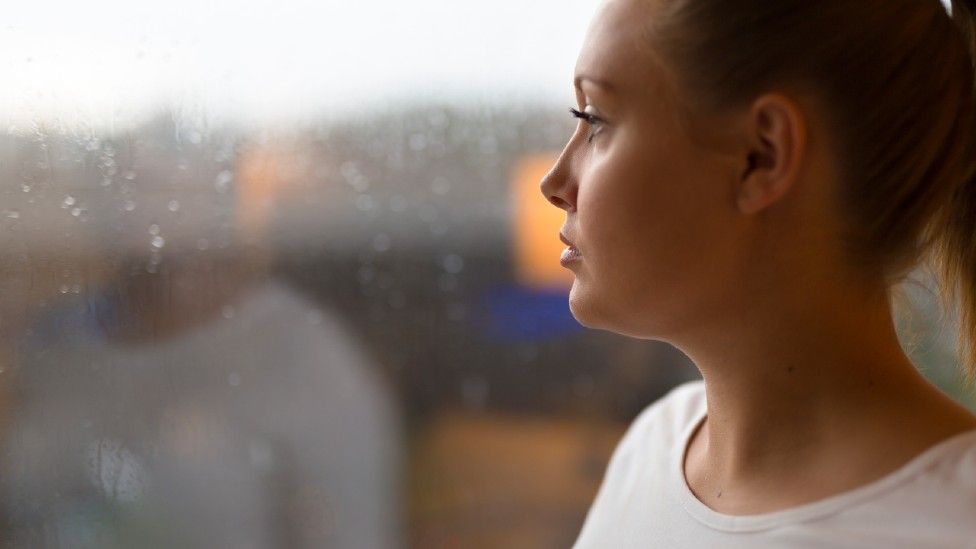Coronavirus: Is it time to free the healthy from restrictions?
- Published
- comments

The constant stream of bad news on coronavirus, from the rising number of deaths, to doctors and nurses risking their lives because of a lack of protective equipment has, understandably, caused great anxiety.
That much is clear from the proportion of adults worried about the threat they believe the virus poses to themselves.
Older people are the most concerned, but even among younger age groups the majority believe they are at risk.
But have we got this out of perspective? How much actual risk does coronavirus present?
The people who are most at risk are older people and those with pre-existing health conditions. The overwhelming majority of deaths has been among these groups.
But young people are, of course still, dying - by late April there had been more than 300 deaths among the under-45s.
What is more, there are many more who have been left seriously ill, struggling with the after-effects for weeks.
So how should we interpret that? And what does that mean for post-lockdown life?
Our constant focus on the most negative impacts of the epidemic means we have "lost sight" of the fact the virus causes a mild to moderate illness for many, says Dr Amitava Banerjee, of University College London.
The expert in clinical data science believes it is important not to jump to conclusions about the deaths of younger, seemingly healthy adults. Some could have had health conditions that had not been diagnosed, he says.
But he admits there will be otherwise healthy people who have died - as happens with everything from heart attacks to flu.
In future, we need to stop looking at coronavirus through such a "narrow lens", he says. Instead we should take more account of the indirect costs, such as rising rates of domestic violence in lockdown, mental health problems and the lack of access to health care more generally.
A 'nasty flu' for many
On Sunday Boris Johnson is expected to set out how restrictions will be eased in England. All indications are that it will be a very gradual process to keep the rate of transmission of the virus down.
But some believe we do not need to be so draconian.
Edinburgh University and a group of London-based academics published a paper this week arguing restrictions could be lifted quite significantly if the most vulnerable were completely shielded.
That would require the continued isolation of these individuals and the regular testing of their carers - or shielders as the researchers call them.
If we could protect them - and that would require very good access to quick testing and protective equipment - the researchers believe we could lift many restrictions and allow a "controlled" epidemic in the general population.
Good hand-hygiene, isolating when you have symptoms and voluntary social distancing where possible would be needed. But people could return to work, and school - in a matter of months. The majority could even be eating in restaurants and going to cinemas.
For the non-vulnerable population, coronavirus carries no more risk than a "nasty flu", says Prof Mark Woolhouse, an expert in infectious disease who led the research.
"If it wasn't for the fact that it presents such a high risk of severe disease in vulnerable groups, we would never have taken the steps we have and closed down the country.
"If we can shield the vulnerable really well, there is no reason why we cannot lift many of the restrictions in place for others.
"The lockdown has come at a huge economic, social and health cost."
It is, he says, all about getting the balance of risk right.
- A SIMPLE GUIDE: How do I protect myself?
- AVOIDING CONTACT: The rules on self-isolation and exercise
- IMMUNITY: Can you catch the virus twice?
- HOPE AND LOSS: Your coronavirus stories
- LOOK-UP TOOL: Check cases in your area
A risk to live with
It is a point others have made.
Cambridge University statistician Prof Sir David Spiegelhalter has highlighted evidence which shows the risk of dying from coronavirus is very similar to the underlying risk people of all age groups from early 20s upwards have of dying anyway.
His point is that for the average adult getting infected means you are effectively doubling your risk of death. The younger you are, the lower the risk.
For children, as you can see on the graph, the risk from the virus is so small that you might be better off worrying about other things. After the first year of life cancers, accidents and self-harm are the leading causes of death.
Researchers from Stanford University in the US have been trying to count the risk another way - equating it to that which we face from dying while driving.
In the UK, they calculate that those under the age of 65 have faced the same risk over the past few months from coronavirus as they would have faced from driving 185 miles a day - the equivalent of commuting from Swindon to London.
Strip out the under-65s with health conditions - about one in 16 - and the risk is even lower, with deaths in non-vulnerable groups being "remarkably uncommon".
Putting risk in perspective is going to be essential for individuals and decision-makers, the authors suggest.
If we do, we may learn to live with coronavirus. We may have to.
- Published16 April 2020
- Published29 April 2020
- Published30 March 2020
- Published4 August 2019
- Published6 January 2019
- Published8 February 2017
- Published8 February 2017
- Published6 January 2017